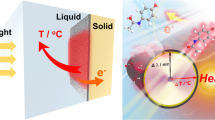Abstract
We have developed a fiber-optic chemical sensor for on-line monitoring of fermentation pH. The sensor is based on a covalently bound fluorescent dye immobilized within a water-permeable polymer layer on an optical fiber. Measurements were performed on a portable fluorimeter and employed a ratiometric approach to account for system instabilities. We show that the use of this fiber-optic sensor provides fast, accurate and reliable measurements during E. coli fermentation in a complex medium.
This is a preview of subscription content, access via your institution
Access options
Subscribe to this journal
Receive 12 print issues and online access
$209.00 per year
only $17.42 per issue
Buy this article
- Purchase on Springer Link
- Instant access to full article PDF
Prices may be subject to local taxes which are calculated during checkout
Similar content being viewed by others
References
Arnold, M.A. 1992. Fiber-optic chemical sensors. Analyt. Chem. 64: 1015–1025.
Wolfbeis, O.S. 1990, Chemical sensors-survey and trends. Fresenius J. Analyt. Chem. 337: 522–527.
Camara, C., Moreno, M.C. and Orellana, G. 1991. title of paper?, p. 37–40. In: Biosensors with Fiberoptics. Wise, D. L. and Wingard, L. B. (Eds.). Humana Press, Clifton, NJ.
Saari, L.A. and Seitz, W.R. 1982. pH sensor based on immobilized fluorescein amine. Anal. Chem. 54: 821–823.
Munkholm, C., Walt, D.R., Milanovich, F.P. and Klainer, S.M., 1986. Polymer modification of fiber optic chemical sensors as a method of enhancing fluorescence signal for pH measurements. Analyt. Chem. 58: 1427–1430.
Barnard, S. and Walt, D.R. 1991. title? Nature 353: 338–340.
Tan, W., Shi,Z.-Y., Smith, S., Bimbaum, D. and Kopelman, R. 1992. Submicrometer intracellular chemical optical fiber sensor. Science 258: 778–781.
Posch, H.E., Leiner, M.J.P. and Wolfbeis, O.S. 1989. Towards a gastric pH sensor: an optrode for the 0–7 pH range. Fresenius Z. Anal.Chem. 334: 162–165.
Wolfbeis, O.S. 1990. Fiber-optic sensors in bioprocess control, p. xxx–xxx? In: Sensors in Bioprocess Control. Twork, J. V., and Yacynych, A. M (Eds.). Publisher. Place of Pub?
Li, J.-K., Asali, E.C., Humphrey, A.E. and Horvath, J.J. 1991. Monitoring cell concentration and activity by multiple excitation fluorometry. Biotechnol. Progress 7: 21–27.
Li, J.-K., and Humphrey, A.E., 1991. Use of fluorometry for monitoring and control of a bioreactor. Biotechnol. Bioeng. 37: 1043–1049.
Coppella, S.J. and Rao, G. 1990. Practical considerations in the measurement of culture fluorescence. Biotechnol. Prog. 6: 398–401.
Scheper, T., Lorenz, T., Schmidt, W. and Schugerl, K. 1986. Measurement of culture fluorescence during the cultivation of Penicillium chrysogenum and Zymomonas mobilis. J. Biotechnol. 3: 231–238.
Hancher, C.W., Thacker, L.H. and Phares, E.F., 1978. A fiber-optic retroreflective turbidimeter for continuously monitoring cell concentration during fermentation. Bioteehnol. Bioeng. 16: 475–484.
Kennedy, M.J., Thakur, M.S., Wang, D.I.C. and Stephanopoulos, G. 1992. Estimating cell concentration in the presence of suspended solids: A light scatter technique. Biotechnol. Bioeng. 40: 875–888.
Junker, B.H., Wang, D.I.C. and Hatton, T.A. 1988. Fluorescence sensing of fermentation parameters using fiber optics. Biotechnol. Bioeng. 32: 55–63.
Kisaalita, W.S., Sininger, P.J., Bothas, R.J., McCarthy, J.F. and Magin, R.L. 1991. Application of fiber-optic fluorescence measurements to on-line pH monitoring of a Pseudomonad fermentation process. Biotechnol. Progress. 7: 564–569.
Kroneis, H.W. and Marsoner, H.J. 1983. A fluorescence-based sterilizable oxygen probe for use in bioreactors. Sensors and Actuators 4: 587–592.
Weigl, B.H., Holobar, A., Kraus, H., Gouber, W., Wollschlager, A. and Wolfbeis, O.S. 1993. Optical triple sensor for measuring pH, oxygen and carbon dioxide in bioreactors. Proc. SPIE. In press.
Zhang, Z. and Seitz, W.R. 1984. A fluorescence sensor for quantifying pH in the range from 6.5 to 8.5. Analyt. Chim. Acta. 160: 47–55.
Munkholm, C., 1989. Tufts University. PhD thesis.
Martin, M.M. and Lindquist, L. 1975. The pH dependence of fluorescein fluorescence. J. Luminescence 10: 381–390.
Munkholm, C., Parkinson, D.-R. and Walt, D.R. 1990. Intramolecular fluorescence self-quenching of fluoresceinamine. JACS 112: 2608–2612.
Taylor, F.R. and Cronan, J.E. Jr. 1979. Cyclopropane fatty acid synthase of E. coli. Stabilization, punfication, and interaction with phospholipid vesicles. Biochemistry 18: 3292–3300.
Author information
Authors and Affiliations
Rights and permissions
About this article
Cite this article
Agayn, V., Walt, D. Fiber-optic Sensor for Continuous Monitoring of Fermentation pH. Nat Biotechnol 11, 726–729 (1993). https://doi.org/10.1038/nbt0693-726
Received:
Accepted:
Issue Date:
DOI: https://doi.org/10.1038/nbt0693-726



